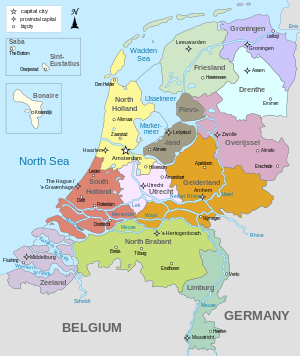
Back Provinsies van Nederland Afrikaans Provincias d'os Países Baixos AN مقاطعات هولندا Arabic Провинции на Нидерландия Bulgarian Proviñsoù an Izelvroioù Breton Província dels Països Baixos Catalan Provincie v Nizozemsku Czech Taleithiau'r Iseldiroedd Welsh Provinser i Nederlandene Danish Provinz (Niederlande) German
| Provinces of the Netherlands | |
|---|---|
 Clickable map of provinces | |
| Category | Unitary unit |
| Location | Kingdom of the Netherlands |
| Number | 12 provinces 3 special municipalities |
| Populations | Least: Zeeland, 391,124 Most: South Holland, 3,804,906 |
| Areas | Smallest (including water): Utrecht, 1,560 km2 (602 sq mi) Largest (including water): Friesland, 5,753 km2 (2,221 sq mi) |
| Government | |
| Subdivisions | |
There are twelve provinces (Dutch: provincies [proːˈvɪnsis] ⓘ or provinciën [proːˈvɪnsijə(n)] ⓘ; sing. provincie [ˌproːˈvɪnsi] ⓘ) of the Netherlands representing the administrative layer between the national government and the local governments, with responsibility for matters of subnational or regional importance.
The most populous province is South Holland, with just over 3.8 million inhabitants as of January 2023[update], and also the most densely populated province with 1,410/km2 (3,700/sq mi).[1] With 391,124 inhabitants, Zeeland has the smallest population. However Drenthe is the least densely populated province with 191/km2 (490/sq mi). In terms of area, Friesland is the largest province with a total area of 5,753 km2 (2,221 sq mi). If water is excluded, Gelderland is the largest province by land area at 4,960 km2 (1,915 sq mi). The province of Utrecht is the smallest with a total area of 1,560 km2 (602 sq mi), while Flevoland is the smallest by land area at 1,410 km2 (544 sq mi). In total about 10,000 people were employed by the provincial administrations in 2018.[2]
The provinces of the Netherlands are joined in the Association of Provinces of the Netherlands (IPO). This organisation promotes the common interests of the provinces in the national government of the Netherlands in The Hague.
- ^ Cite error: The named reference
CBS_key_figswas invoked but never defined (see the help page). - ^ "Personeelsmonitor Provincies". A&O-fonds Provincies (in Dutch). 2 July 2019. Retrieved 26 October 2019.